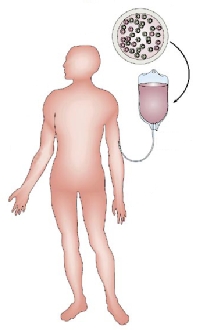
Chronic infections by viruses such as HIV or hepatitis C eventually take hold because they wear the immune system out, a phenomenon immunologists describe as exhaustion.
Yet exhausted immune cells can be revived after the introduction of fresh cells that act like coaches giving a pep talk, researchers at Emory Vaccine Center have found. Their findings provide support for an emerging strategy for treating chronic infections: infusing immune cells back into patients after a period of conditioning.
The results are published this week in Proceedings of the National Academy of Sciences Early Edition.
The first author of the paper is Rachael Aubert, a student in Emory’s Immunology and Molecular Pathogenesis program who completed her doctorate in 2009. Senior author Rafi Ahmed, PhD, is director of the Emory Vaccine Center and a Georgia Research Alliance Eminent Scholar.
Ahmed’s laboratory has extensive experience studying mice infected with lymphocytic choriomeningitis virus (LCMV). Immune responses against LCMV are driven by CD8 or “killer” T cells, which destroy virus-infected cells in the body. But a few weeks after exposure to LCMV, the mice develop a chronic infection that their immune systems cannot shake off, similar to when humans are infected by viruses like HIV and hepatitis C.
Aubert and her co-workers examined what happened to mice chronically infected with LCMV when they infused CD4 or “helper” T cells from uninfected mice. After the infusion, the CD8 cells in the infected mice revived and the levels of virus in their bodies decreased by a factor of four after a month. Like coaches encouraging a tired athlete, the helper cells drove the killer cells that were already in the infected mice to emerge from exhaustion and re-engage.
The cell-based treatment was especially effective when combined with an antibody that blocks the molecule PD-1, which appears on exhausted T cells and inhibits their functioning. The antibody against PD-1 helps the exhausted T cells to revive, and enhances the function of the helper cells as well: the combination reduced viral levels by roughly ten-fold, and made the virus undetectable in some mice.
“We have not seen this sharp of a reduction in viral levels in this system before,” says co-author Alice Kamphorst, a postdoctoral fellow.
The helper cells were all genetically engineered to recognize LCMV, a difference between mouse experiments and potential clinical application. However, it may be possible to remove helper T cells from a human patient and stimulate them so that all the cells that recognize a given virus grow, Kamphorst says.
“This is an active area of research and several laboratories are looking at how best to stimulate T cells and re-introduce them,” she says.
In addition, she and her co-workers are examining what types of hormones or signaling molecules the helper cells provide the killer cells. That way, that molecule could be provided directly, instead of cell therapy, she says.
The molecule PD-1 was previously identified by Ahmed and colleagues as a target for therapy designed to re-activate exhausted immune cells. Antibodies against PD-1 have been undergoing tests in clinical studies against hepatitis C and several forms of cancer.
Collaborators from Harvard Medical School/Dana Farber Cancer Institute contributed to the paper. The research was supported by the National Institutes of Health and the Cancer Research Institute.
Reference: R.D. Aubert et al. Antigen-specific CD4 T-cell help rescues exhausted CD8 T cells during chronic viral infection. PNAS Early Edition (2011).
Writer: Quinn Eastman
